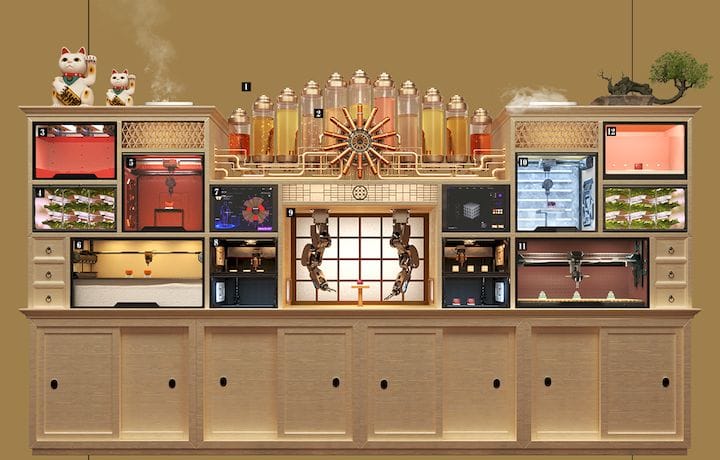![A customized 3D printed sushi machine [Source: Open Meals]](https://fabbaloo.com/wp-content/uploads/2020/05/sushi-ffm_result_img_5eb09abf05267.jpg)
Clearly the 21st century is here, as a restaurant is now set to provide 3D printed customized sushi for curious diners.
I’ve seen and heard plenty of about 3D printed food for many years now, but in most cases it seems to be an impractical possibility. However, this new venture has a new take on the process that just might work.
Japan-based Open Meals wishes to open a restaurant they call “Sushi Singularity”. The premise of this operation will be to use biological information obtained from diners to custom design perfectly nutritional sushi treats for them.
But wait, you ask, “Exactly where does this biological information come from?”
I was afraid you were going to ask about that. Well, it seems that when you make a reservation at Sushi Singularity, you will be sent a kit that you must complete before you can attend the restaurant. The kit is designed to collect biological samples from you, which could include saliva, urine, or feces.
Yes, they are designing your food based on your poop.
![3D printed concept for cultured tuna sushi [Source: Open Meals]](https://fabbaloo.com/wp-content/uploads/2020/05/sushi-tuna_result_img_5eb09abf5e52d.jpg)
The next question I had was regarding the actual production of these food items. It seems that they intend on 3D printing identically-sized cubes containing different foods, nutrition elements, and designs. Throughout this post you will see rendered samples of the items they intend on producing, and some look quite amazing.
One of the challenges in 3D printing food is that usually for anything substantial it takes far too long to print, and hungry diners might just starve while waiting. In other food printing ventures this is overcome by 3D printing items in advance, or making their size so small as to reduce the production time considerably.
![Another incredible 3D printed sushi design [Source: Open Meals]](https://fabbaloo.com/wp-content/uploads/2020/05/sushi-sinter_result_img_5eb09abfa1a12.jpg)
Sushi Singularity seems to have overcome that in an interesting way: the food is not cooked so that time element is eliminated from the equation, the food is printed in small uniformly sized pieces, again reducing time, and the food material does not necessarily have to be extruded in highly complex ways.
However, that does vary by design but all will be 3D printed by their “FFM”, or “Food Fabrication Machine”, seen at top. It’s not entirely clear which 3D printing process will be employed, or whether several will be employed in this device.
Their concept seems quite ambitious, as some of the proposed food items are mechanically activated. Another sample is soup contained in a clear cube. They all look quite interesting.
![Sushi Singularity’s Food Fabrication System [Source: Open Meals]](https://fabbaloo.com/wp-content/uploads/2020/05/image-asset_img_5eb09ac0193d9.jpg)
Digital food design will be done by their specialized software called “FOS”, or “Food Operating System”, to create unique dishes that is vary nutrition, flavors, textures, temperature, shape, colors and other ingredients. Evidently this system will be networked, thus allowing food designers worldwide to link up with the system.
![A highly unusual 3D printed sushi design [Source: Open Meals]](https://fabbaloo.com/wp-content/uploads/2020/05/sushi-hairy_result_img_5eb09ac0699c7.jpg)
Another major challenge they will undergo relates to the privacy of the biological information they are collecting. This would be very similar to the regimes incorporated by the major DNA analysis firms, which is quite extensive. I am having trouble envisioning a single restaurant being able to afford a system of this scale.
Another challenge I foresee with this concept is a bit more subtle. That would be the challenge of convincing customers that this is a good thing. Such challenges are always present when 3D printing is presented to a new set of users. The question here is whether clients will see value in customized sushi, sufficiently so that they will first undergo the possibly-creepy biological sample process, and secondly pay the likely premium charge to visit the restaurant.
On the other hand Tokyo is a city of 13 million people, so it might not be that difficult to find an endless stream of people willing to do this experiment.
I can’t wait to try it, I think.
Via DesignBoom and Sushi Singularity











A Spanish company hopes to develop a specialized 3D printer that is capable of producing vegetarian steaks that both taste good and have great texture. But will you eat one?